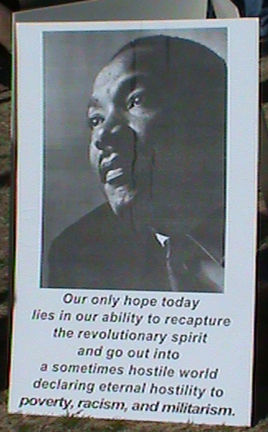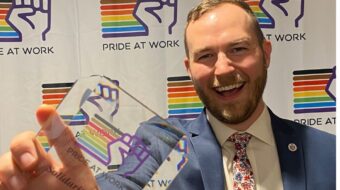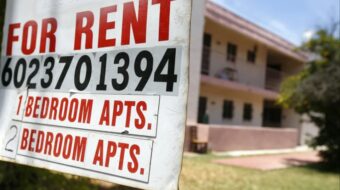
With the remembrance of Dr. Martin Luther King’s legacy and the passing of Sargent Shriver, a foot soldier in the War on Poverty, recently, I have been reading about the early 1960s and listening to speeches by King and President Lyndon B. Johnson.
A recurring theme in these speeches is the struggle to raise Americans out of poverty. In the early 1960s, 20% of Americans lived in poverty, according to National Public Radio. In his first State of the Union address– 47 years ago this month- Johnson declared the War on Poverty- just weeks after taking office following the assassination of President John F. Kennedy.
“This administration today, here and now, declares an unconditional War on Poverty in America. It will not be a short or easy struggle. No single weapon or strategy will suffice, but we shall not rest until that war is won.”
With this declaration, Johnson was continuing Kennedy’s legacy. The War on Poverty led to the creation of Johnson’s Great Society and the largest group of progressive social programs since President Franklin Delano Roosevelt’s New Deal. Many important Great Society programs- aimed at improving labor, health care, and education for poor and working class Americans- are still in existence: Medicare, Medicaid, food stamps, student loans for college, work study, and Head Start.
The result was the poverty rate in the US declined from 20% to 11% by 1973- where it stayed for decades.
Under President Ronald Reagan, a revisionist view of economics became fashionable and the War on Poverty dropped off the national agenda. In its place, scapegoating of the poor became popular. There were rallying cries for small government and welfare reform to root out “welfare cheats.” Rather than educating the poor and helping them into the job market, trickle-down economics preached that giving tax cuts for the rich would allow for investment and the wealth would trickle-down to the masses.
The result of 30 years of trickle-down economics? The rich got richer; 80% of the total increase in income went to the richest 1%. The poor got poorer; the number of Americans living below the poverty line rose from 1.7 million in 2008 to 47 million in 2011- 15.7% of the population. And the middle class is rapidly disappearing.
“When you have one in seven Americans living in poverty. One in five children living in poverty – including one in three African American children and Latino children – and it’s not on America’s radar, something’s very wrong,” which comes from the NPR report.
Indeed it is the shame of our nation that a record 47 million people now live below the poverty line – $22,400 for a family of four – and a stunning one in three Americans are living at less than twice that threshold. And yet we hear so little about this crisis in the mainstream media and Congress, where it seems off the radar not only for the GOP, but even for some of our progressive allies.
But the grim truth is that many of the same structural problems that are making life a struggle for the middle class – and resulted in the first “economic recovery” in 2003-2007 where productivity rose, but median income declined and poverty worsened – are also leading to record numbers of poor people. From 1980 to 2005, more than 80 percent of the total increase in American incomes went to the richest 1 percent. Our economy is super-sizing the wealthy, while producing large quantities of low-wage jobs, unemployment and underemployment, and services are eroding.
The Huffington Post reports, “The latest hunger report by the U.S. Department of Agriculture shows hunger remains at its highest levels in 15 years with 17.4 million households reporting having difficulty feeding their family due to lack of resources.”
“Federal aid is being scaled back, even though growth is not yet robust enough to make a sizable dent in unemployment. Late last year, Republicans blocked the extension of a successful stimulus program that had created 250,000 subsidized jobs for young people and low-income parents. They claimed the stimulus was an expensive failure, even as they pressed to renew the high-end Bush tax cuts. As part of the tax-cut deal, President Obama and Congress agreed to extend federal jobless benefits in 2011, but the checks will be $25 less a week than under the stimulus. That reduction could push an estimated 175,000 more people into poverty in 2011. The deal also included a one-year payroll tax cut that will benefit most workers, but it is less helpful to the lowest-income workers than a now-expired tax break in the stimulus.”
With 14.5 million people still out of work, and more than 6 million of them jobless for more than six months, reducing federal help now will almost ensure more poverty later. That would impose an even higher cost on the economy and budget because ever poorer households cannot spend and consume.
This is shameful: Poverty, hunger, joblessness, and home foreclosures are all running rampant in the U.S., and what is the government doing about it? Nothing. In fact, Republicans and Tea Partiers- now in control of the House of Representatives and many state legislatures- want to lead America backward.
Republican and Tea Partiers in the U.S. House of Representatives wasted two days grandstanding about repeal of the Affordable Healthcare Act- which has already helped millions of Americans secure health care insurance.
On the state level, trickle-down economics is still king. Arizona Governor Jan Brewer and the Arizona Legislature want to knock 280,000 Arizonans off of the Arizona Health Care Cost Containment System (AHCCCS) or eliminate AHCCCS (the state’s Medicaid system) altogether. What happens to these poor people when they lose their health insurance coverage? They’re not going to magically disappear. They will delay treatment and either die on the street or go to emergency rooms- thus increasing the cost of treatment, not to mention increasing suffering. Brewer also proposes slashing university and community college budgets, which will most likely raise tuitions- again- and put a college education further from reach for low- and middle-income residents.
Arizona and other states also are attacking the unions. As a right to work state, union membership in Arizona is already very low. Without the power of organized labor to negotiate wages and benefits, multinational corporations will push wages to historic lows.
The altruistic War on Poverty announced in 1964 seems like a wistful dream now. Today, in its place, conservative politicians are waging a War on the Workers and the Poor.
What happened to the War on Poverty? It was no match for trickle-down economics.
Pamela Powers blogs for TucsonCitizen.com, where this article was originally published.
Photo: Poster from a recent Martin Luther King Jr. march in Tucson. (Pamela Powers)












Comments